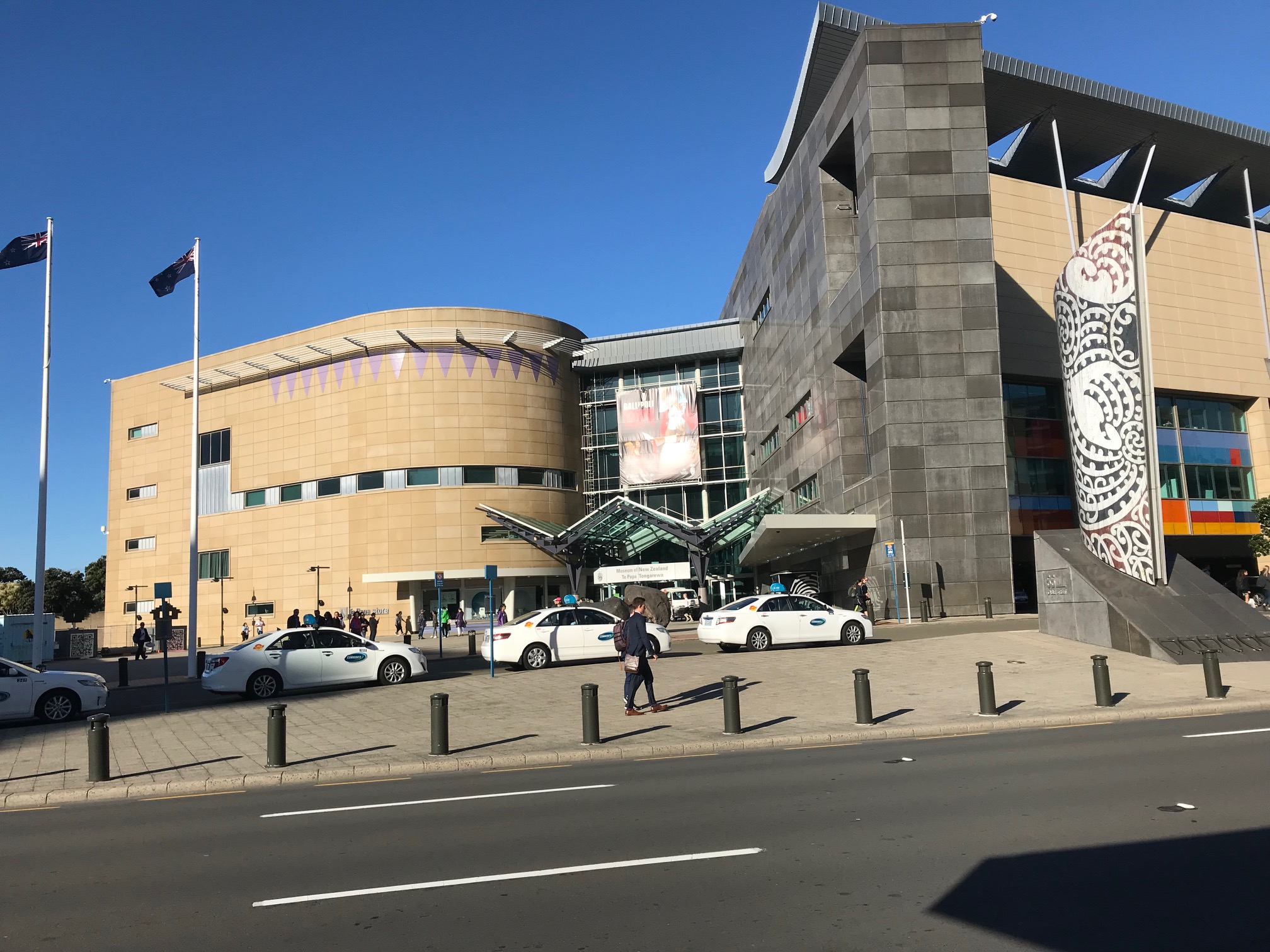
17 Nov TIO NZ: Martinborough to Wellington
In the very first story we posted for this trip, we mentioned how Maori lore describes New Zealand’s North Island as a great fish that got plucked from the sea. Today, the mouth of that fish is Wellington, compact and as pretty a national capital – cultural as well as political – as any in the world.
For better and for worse, Wellington is also San Francisco’s twin: set on the water with steep winding streets, picturesque homes – and at high risk for earthquakes.
The pride of Wellington is Te Papa Tongarewa – Museum of New Zealand, where you go for the calamari – but you stay for the reminder of the horrors of war.

Te Papa, the pride of Wellington, a must when in New Zealand.
On February 22, 2007, something else got plucked from the sea: not an island, rather the largest known squid ever.
The creature had been munching on a hooked tooth fish tethered to the side of a fishing boat, the San Aspiring, working in the Ross Sea in Antarctica. The crew pulled her up on a longline – and off the pages of the Jules Verne classic: she was 33 feet long and weighed in at almost 1,000 pounds.
At 11 inches in diameter, about the size of a soccer ball, her eyes are the largest on record.
Cue Louis Armstrong and “Jeepers Creepers.”

Scientists at Te Papa froze the squid for over a year before dissecting her in spring 2008. She now floats in a tub of formaldehyde, where the sea monster remains on display, the world’s only complete colossal specimen.
However, as spectacular as she is, today the giant squid is, well, dwarfed by the colossal tribute Sir Peter Jackson pays to a group of deceased Kiwi soldiers in a temporary display at Te Papa (up through April 2018) entitled “Gallipoli: The scale of our war.”
The exhibit should be mandatory for all in positions of power, for anyone able to unleash the proverbial dogs of war.

(And just in case you have been living in a hobbit hole, Jackson is a Kiwi and the Oscar-winning writer-director of the cinematic adaptation J.R.R. Tolkien’s Lord of the Rings trilogy.)
“Gallipoli” tells the story through the eyes and words of eight ordinary New Zealanders who found themselves stranded in a variation on theme of hell with its epicenter a peninsula in the southern part of East Thrace, the European part of Turkey. Each of these individuals is represented in monumental scale – 2.4 times human size – frozen in a moment of time and captured in extraordinary detail. Viewers actually get to see thee blood, sweat and tears of these heroic titans, each of whom made the ultimate sacrifice for the crown.
The giant sculptures took a staggering 24,000 hours to create and countless hours were spent researching their rich histories.
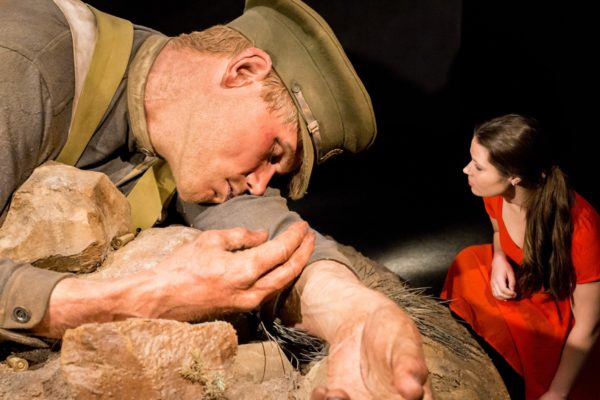
Cutting-edge technology was also used to create 3-D maps and projections, miniatures, models, dioramas, and a range of interactive experiences that bring New Zealand’s Gallipoli story to life.
As prime minister, Winston Churchill boldly led Britain to victory in World War II. But 25 years before that, as political head of the British Royal Navy, he championed a World War I military attack that ended in the disaster that was Gallipoli.
In a number of scenes in the Joe Wright’s biopic about Churchill, “The Darkest Hour,” one of the buzziest films at the Telluride Film Festival, Churchill’s political enemies attempted to weaponize Gallipoli against him. But when Churchill became prime minister in 1940, with Britain once again embroiled in war, upon taking office, he wrote, “All my past life had been a preparation for this hour and for this trial.”
That included Gallipoli.
But great leaders like Churchill learn from their mistakes.
And Wright has said that his film is all about the nature of greatness and leadership – in direct and sharp contrast with America’s current void.
But that takes us off on a whole other tangent…
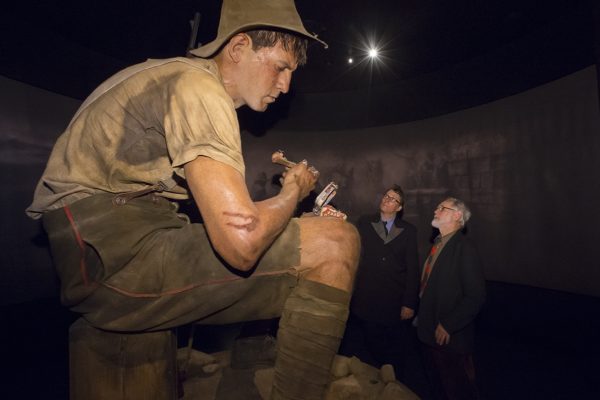
In total, 2,779 Kiwis lost their lives on Gallipoli; many others were scarred for life. Jackson’s “Gallipoli: The scale of our war,” truly a momentous collaboration between the worlds of movies, model-making, and museums, takes viewers to the core of that defining event.
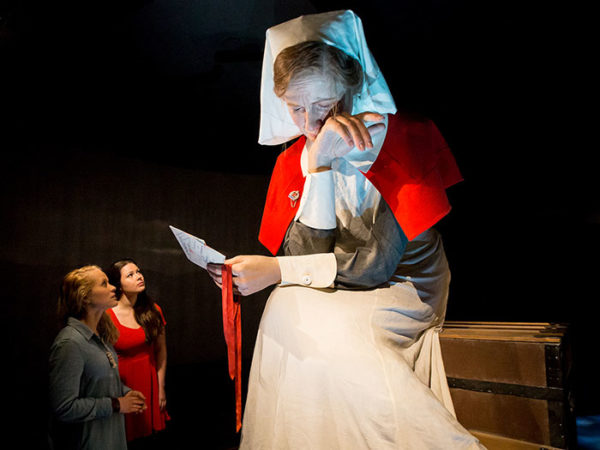
“Gallipoli: The scale of our war” is the centerpiece of Te Papa’s comprehensive four-year “Conflict and Identity Program” of research, discussion, and reflection on the dynamics of conflict and its impact on our national identity.
Which, of course, includes Maori history.
Another major no-miss exhibit up at Te Papa now is “Ko Rongowhakaata: The Story of Light and Shadow,” which explore the land, people, and stories of Rongowhakaata, a Maori iwi or tribe whose unique art reflects their innate creativity, rich history, and innovative spirit.

Maori waka or sacred vessel.
Te Papa is the pride of Wellington with good reason.
We spent about five hours touring the museum.
For more on Te Papa, go here.
One of Wellington’s other most popular tourist attractions is the Cable Car, which runs from downtown Wellington to the picturesque suburb of Kelburn and the lovely Wellington Botanic Garden.

A favorite of locals and visitors like us, Wellington’s Cable Car allows easy access from the central business district to the lookout. Then a five-minute historic trip provides access to stunning views over the city and down to the harbor, Te Whanganui-a-Tara.

View from the top of the Cable Car.
Part of the ride is through a tunnel which flashes with multi-colored lights. A tribute to New Zealand’s famous glow worm caves?
Where to stay/eat in Wellington:

A hippo guards the entrance to the Museum Hotel.
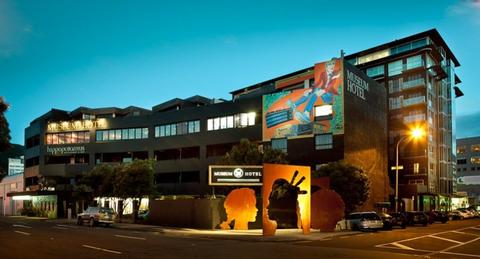
We stayed conveniently enough directly across the street from Te Papa at the aptly named Museum Hotel, home to one of New Zealand’s most eccentric art collections, over 160 original works created by local and national artists and curated by the hotel’s ambassador and previous owner, Chris Parkin.
The place is cool and glam and features all the amenities, including French-inspired dining at Hippopotamus. We had a great dinner and delightful evening there with our new besties, a Scottish couple we first met in Napier on the walking tour.

Why hippos? (One also guards the gates of the hotel’s entrance.)
We understand the answer is just because. (Or more or less the same answer to question of why the Elephant Hill winery got named Elephant Hill, when there are no hills around. No elephants in New Zealand either.)
Hippos are apparently all about Parkin’s eccentricity, underlined by the man’s fondness for art with, in his words, “a lot of personality” or “tits and bums.”
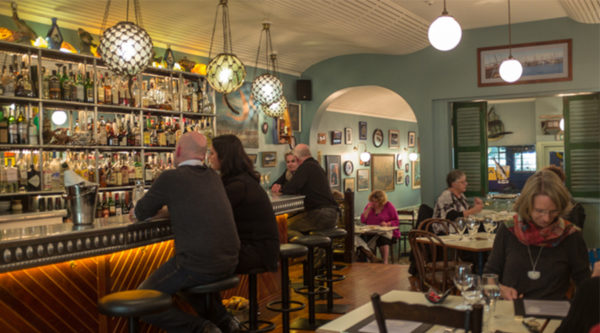
Thank heaven our new Scottish friends recommended Ortega’s or we might have missed one the best evenings of the trip. The place with a come-to-the-neighborhood vibe is indeed a popular local hang which offers upscale, creative fish dishes (and steaks) in a warm, bustling ambience.
The manager Davey took us under his wings, so we feasted on yellowtail kingfish sushi and John Dory over risotto and I got to sample a hot-off-the-presses local vodka from Reid & Reid Distillery, best known for its gin.
Reid & Reid is located in picturesque Martinborough which, in the 1990s, became a major wine producer, especially known today for its Pinot Noir.
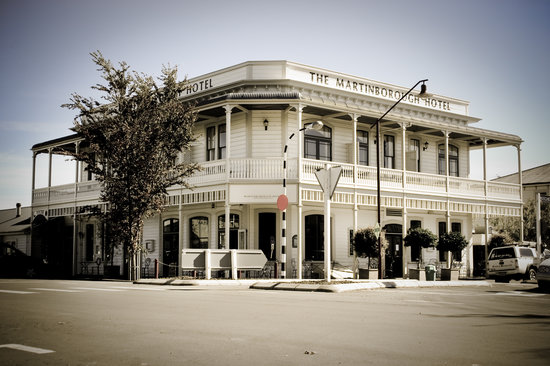
Thanks to yet another recommendation from Janine McCutheon of Hawke’s Bay Bespoke tours, we made a stop in Martinborough on our way to Wellington, stopping for lunch at the historic – read opened in 1886 – Martinborough Hotel, where the bartender, recommended Tarakini fish and the local Palliser Estate Pinot.


Sorry, the comment form is closed at this time.